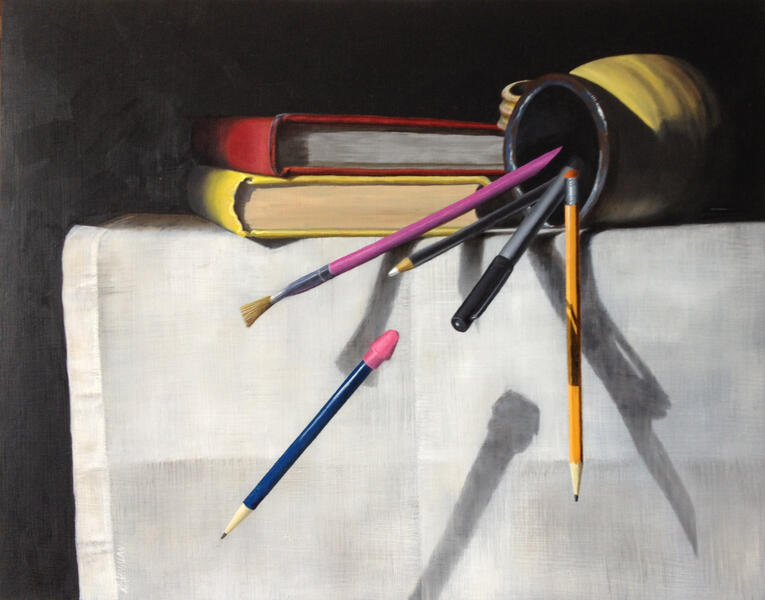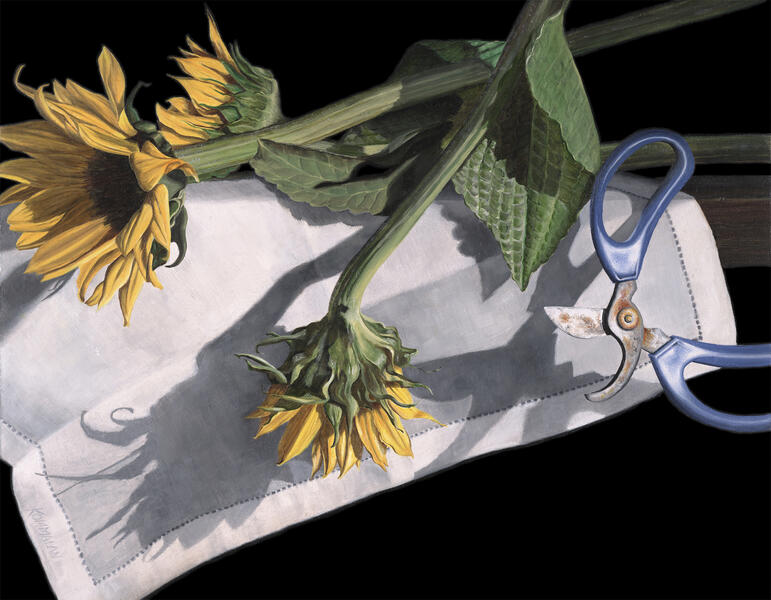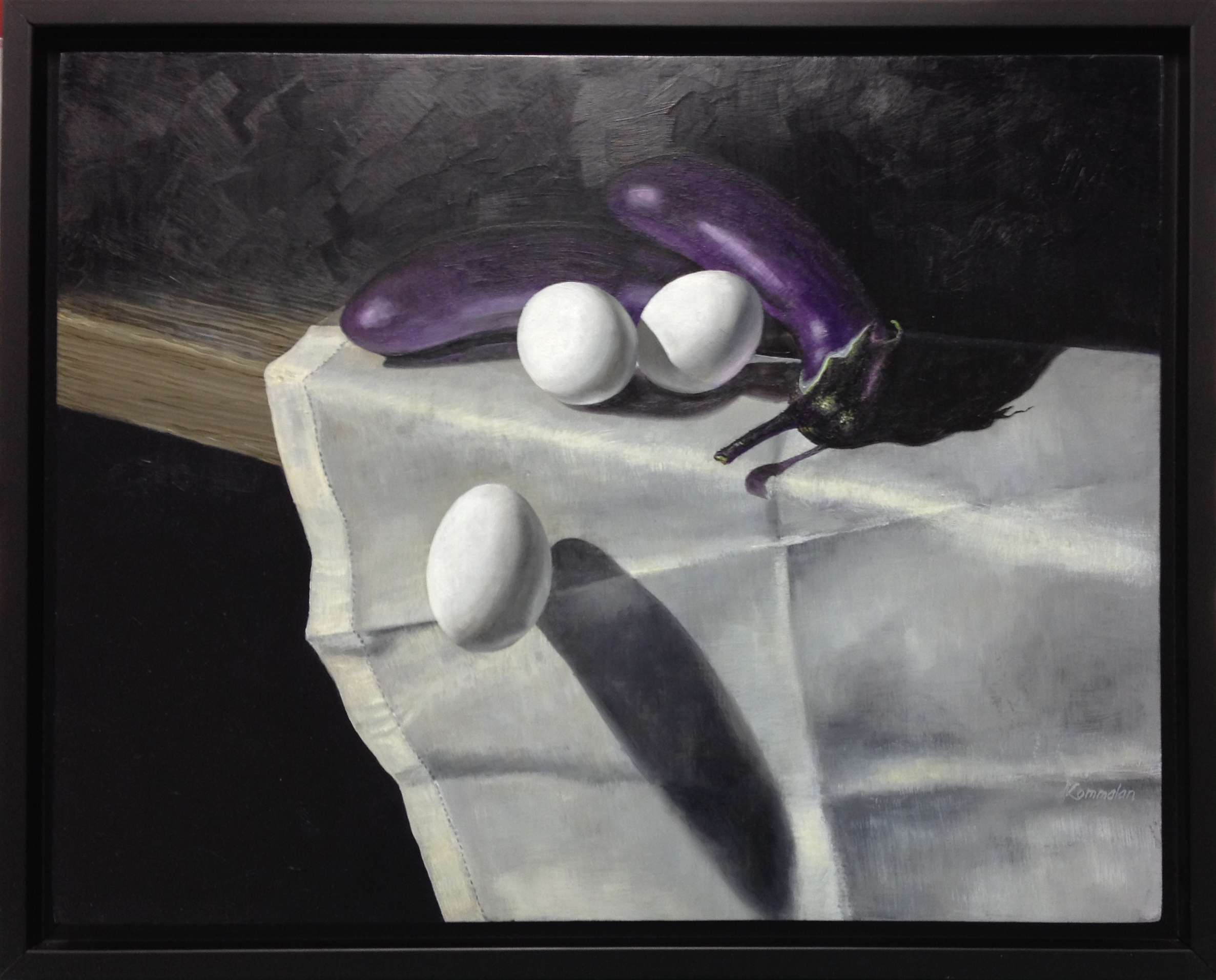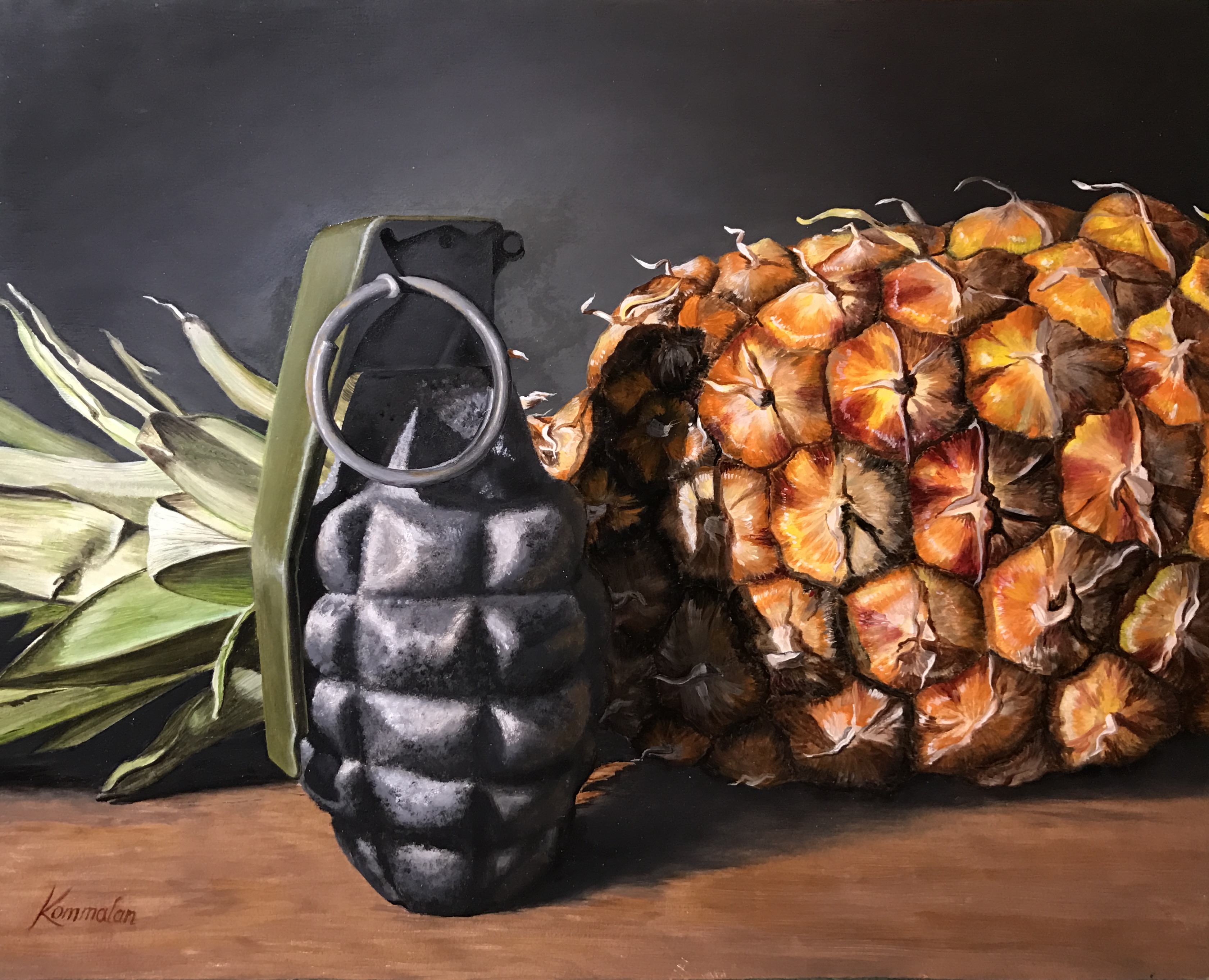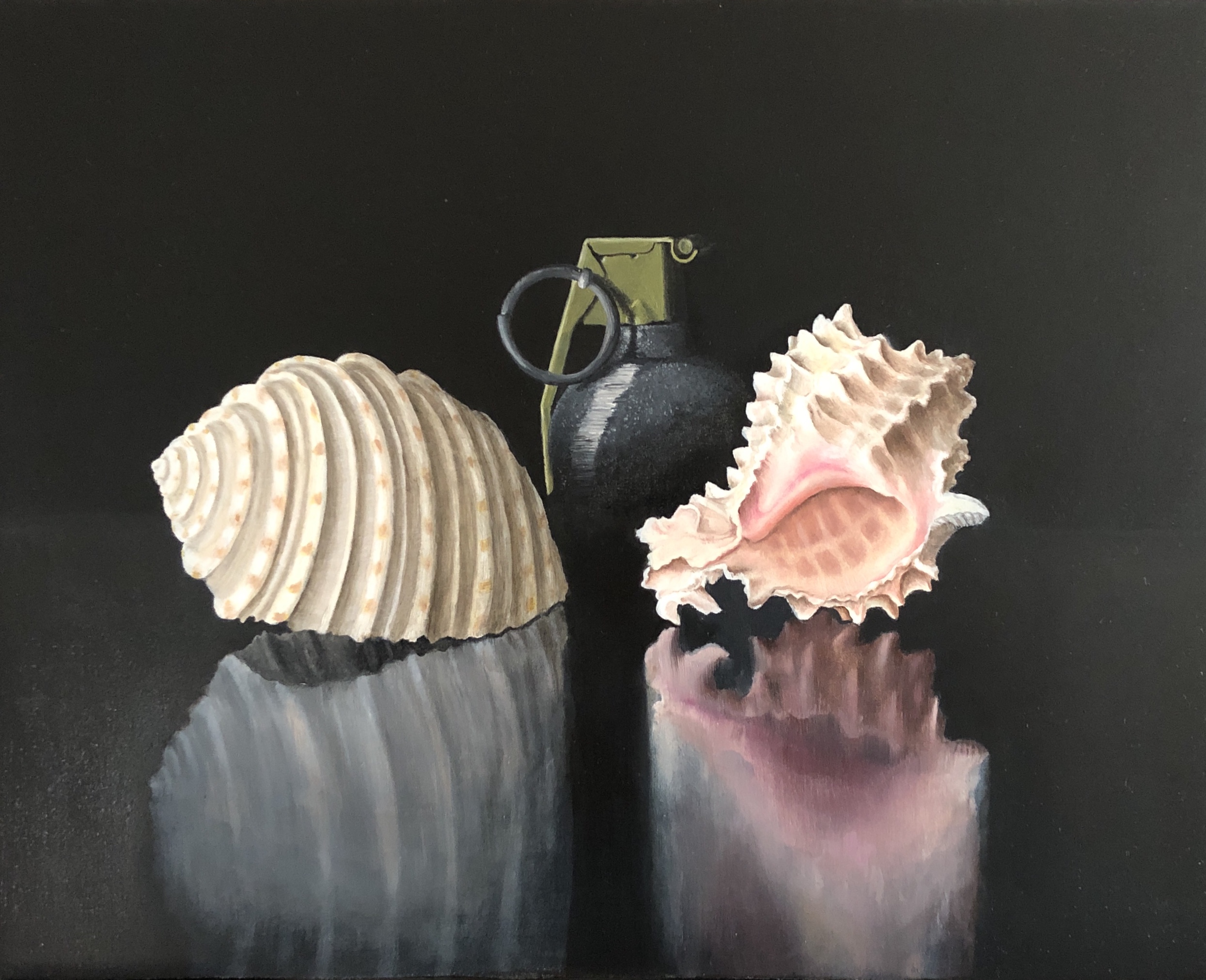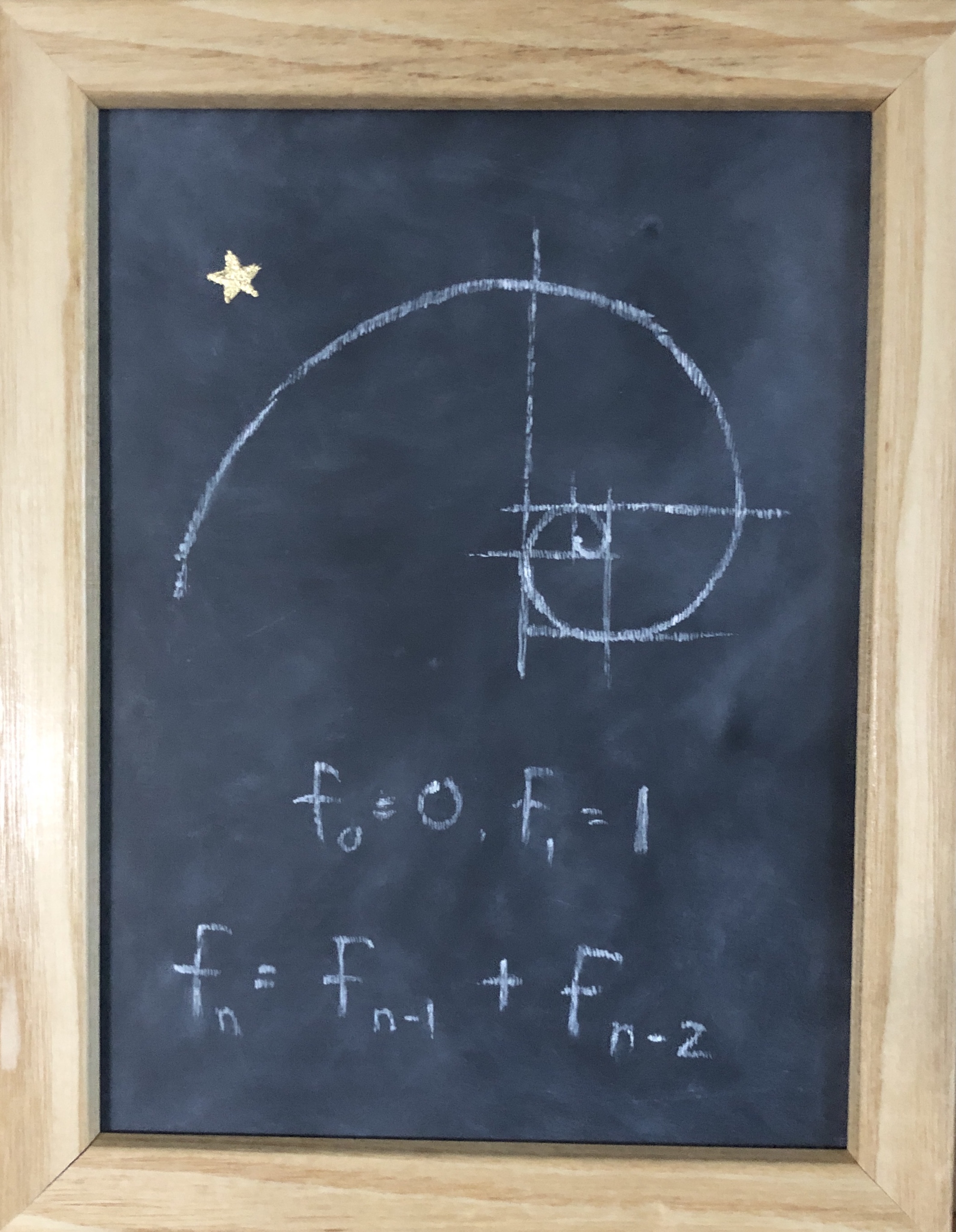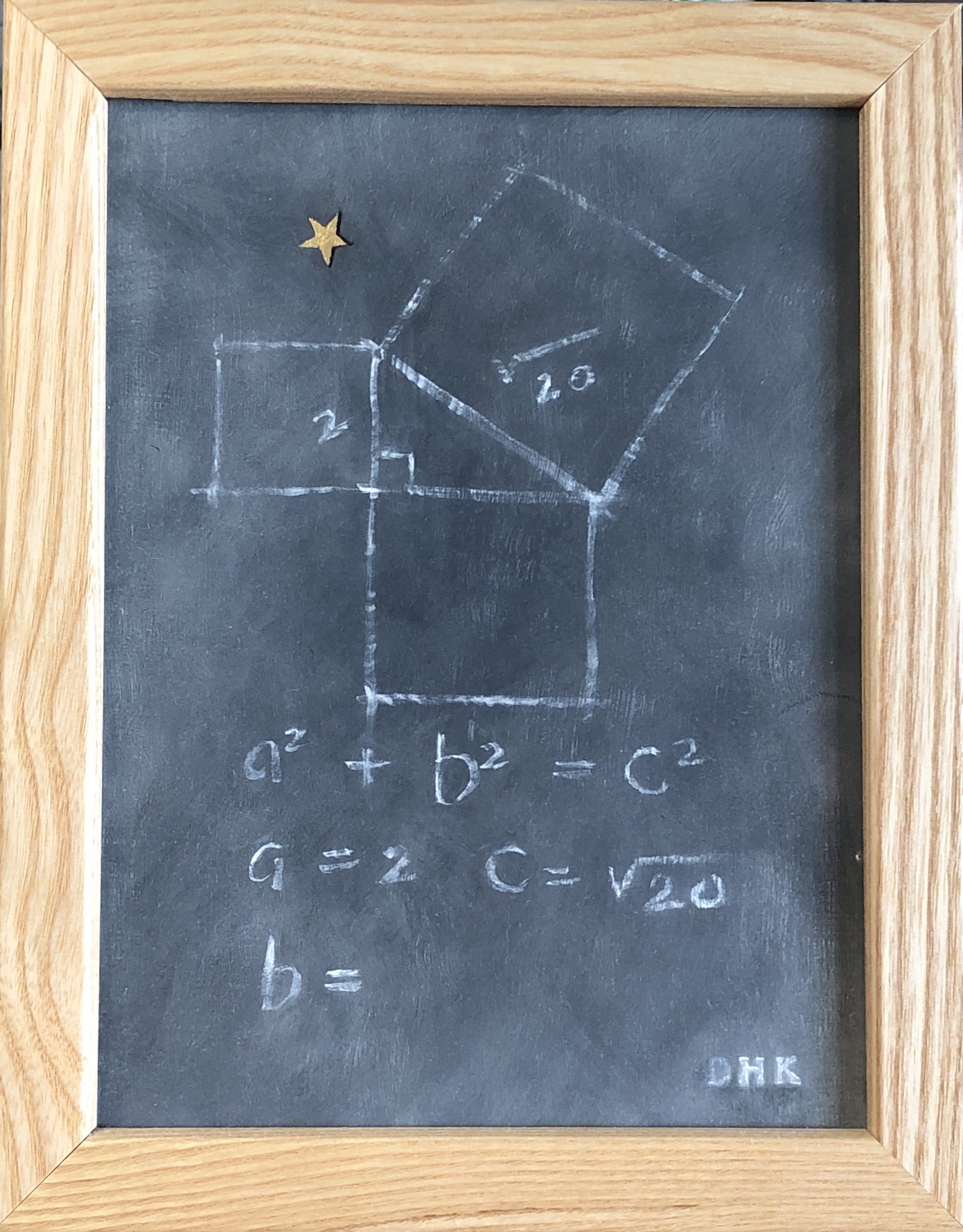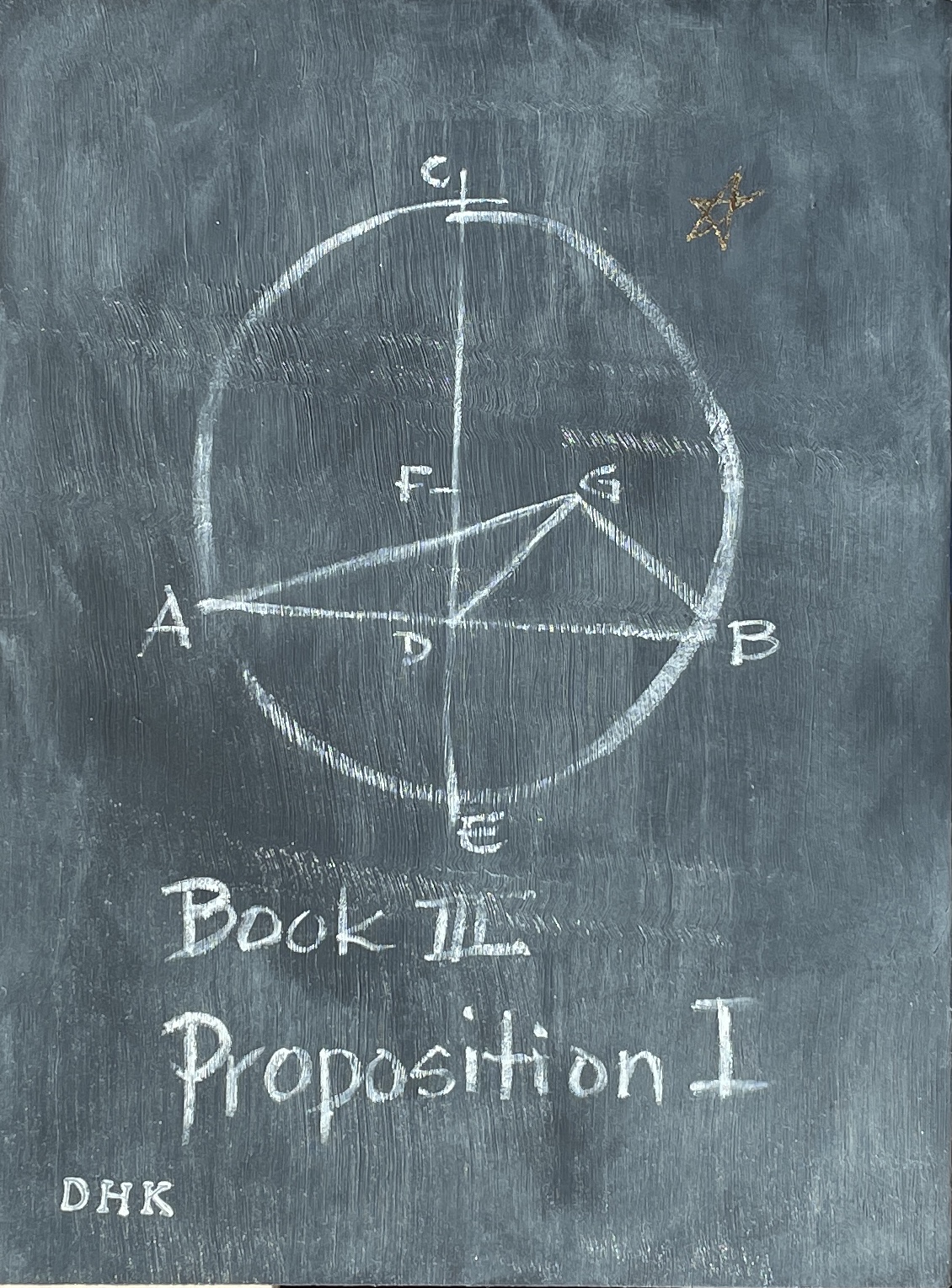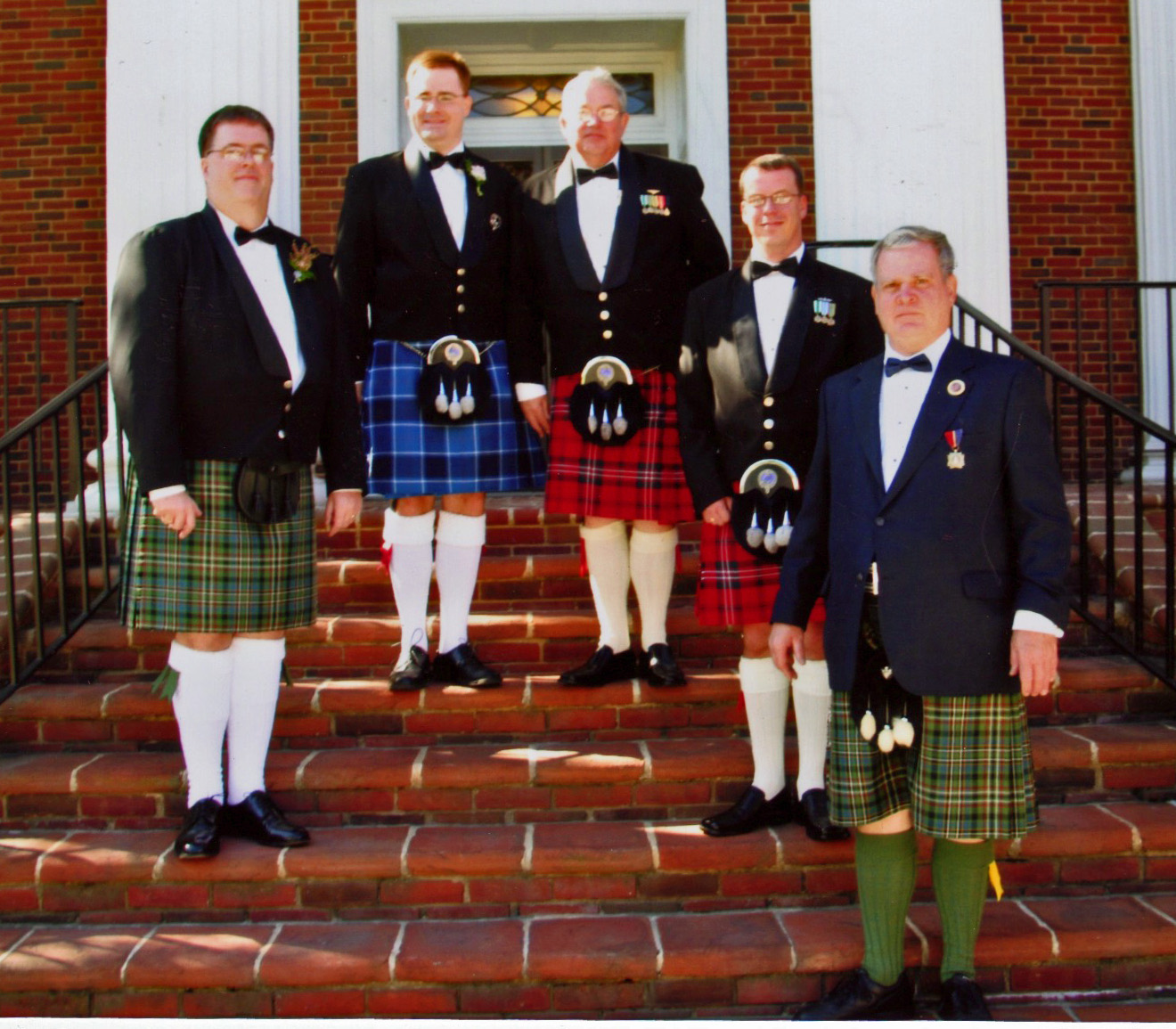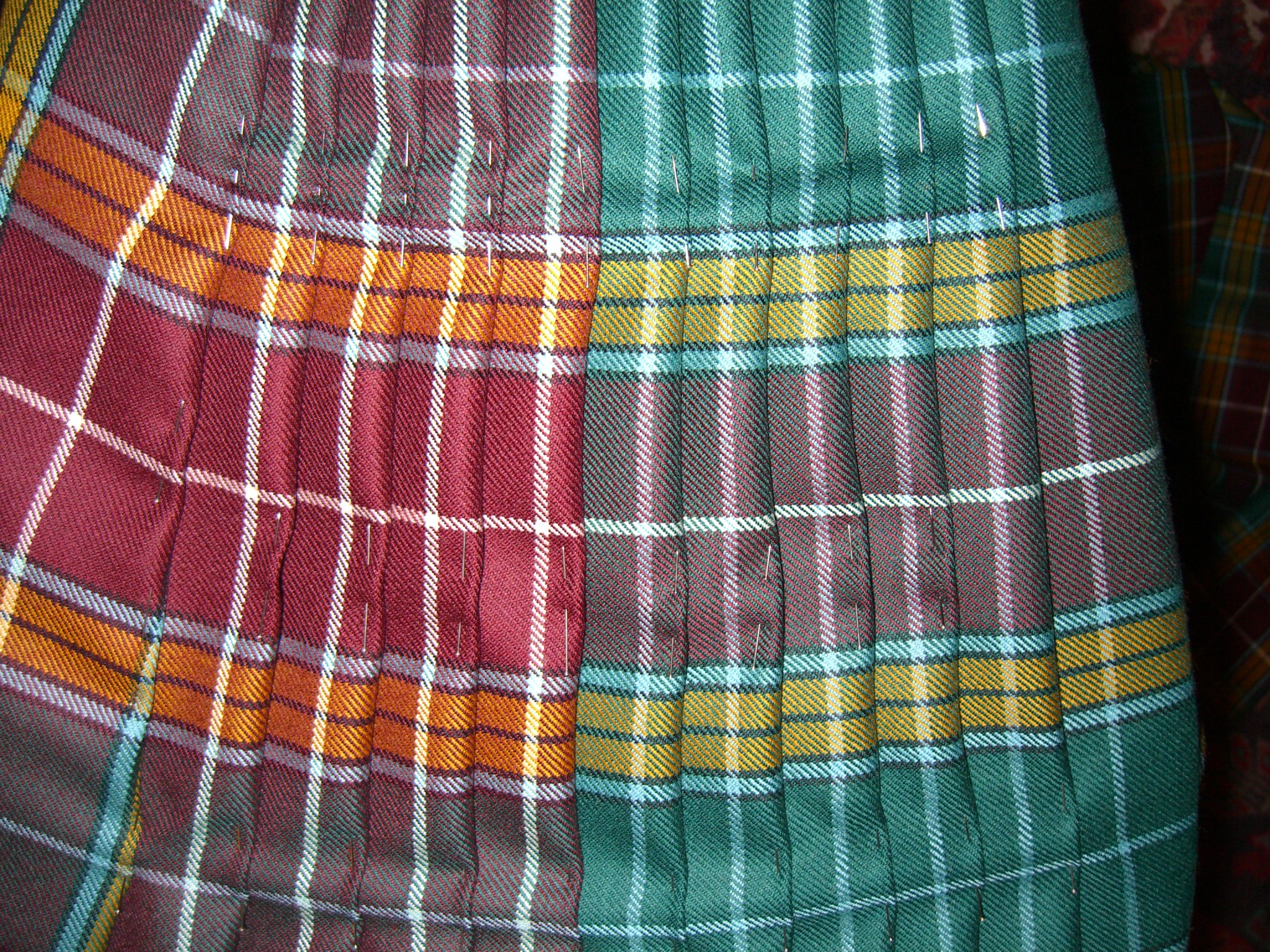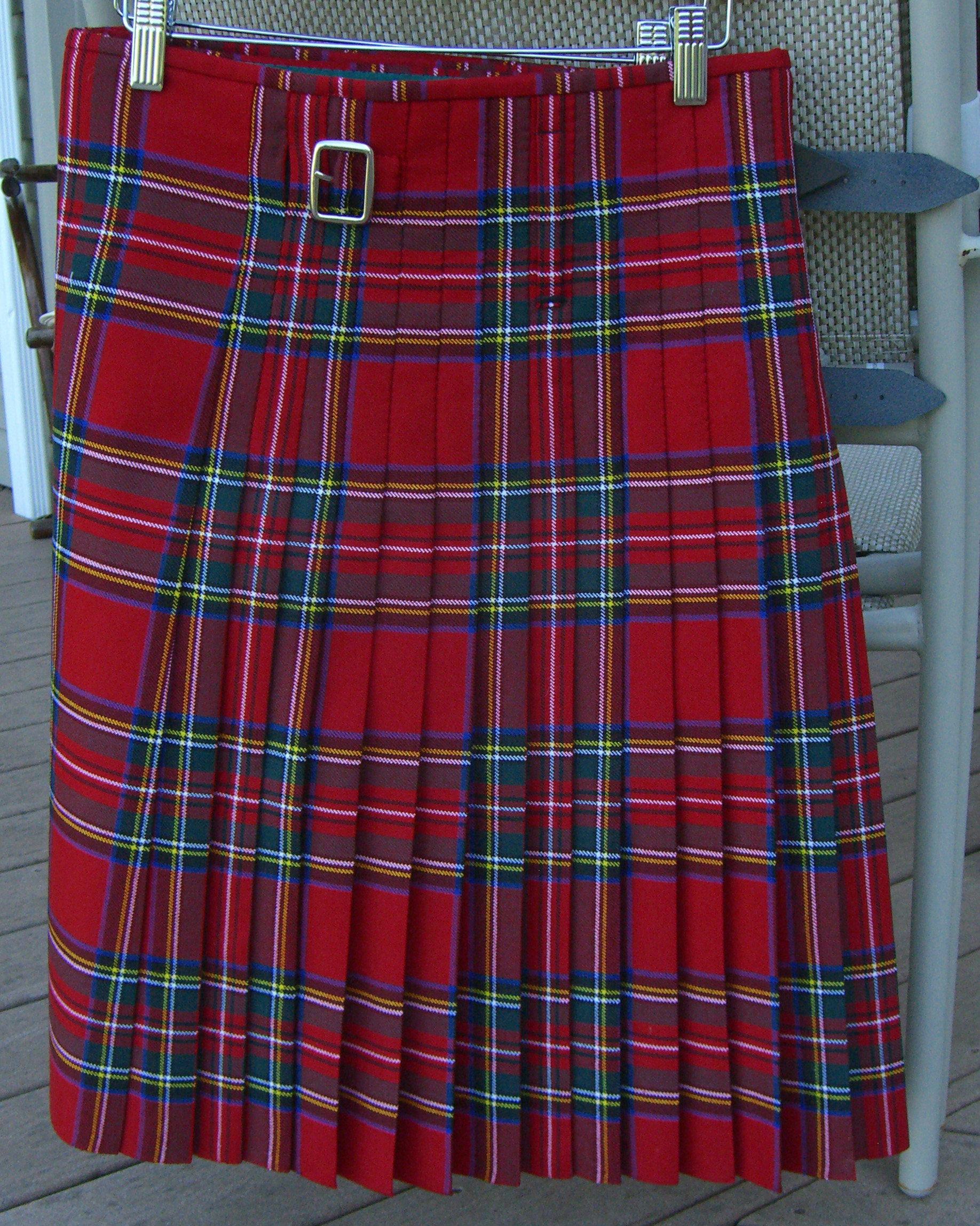Work samples
About Deborah

Deborah was born in Baltimore. She graduated from the Maryland Institute, College of Art, in 1970, with a diploma in Graphic Design. She studied basic painting as part of the freshman foundation but never pursued it.
After a forty-year hiatus, she returned to painting and has continued her practice for the last 18 years. To strengthen her skills as an emerging artist, she studied oil painting at Anne Arundel Community College for 5 years, studying with Leonard Koscianski, Richard… more
Jump to a project:
Still Lifes
In the course of study, I tried my hand at painting in the style of Luis Melendez, an 18th century Spanish still life painter.
The aim of these exercises was to understand this artist's techniques, then to go on and incorporate parts of this style into my own works.
In the later paintings, I have endeavored to show movement in still life. This is proving to be a popular idea.
The aim of these exercises was to understand this artist's techniques, then to go on and incorporate parts of this style into my own works.
In the later paintings, I have endeavored to show movement in still life. This is proving to be a popular idea.
-
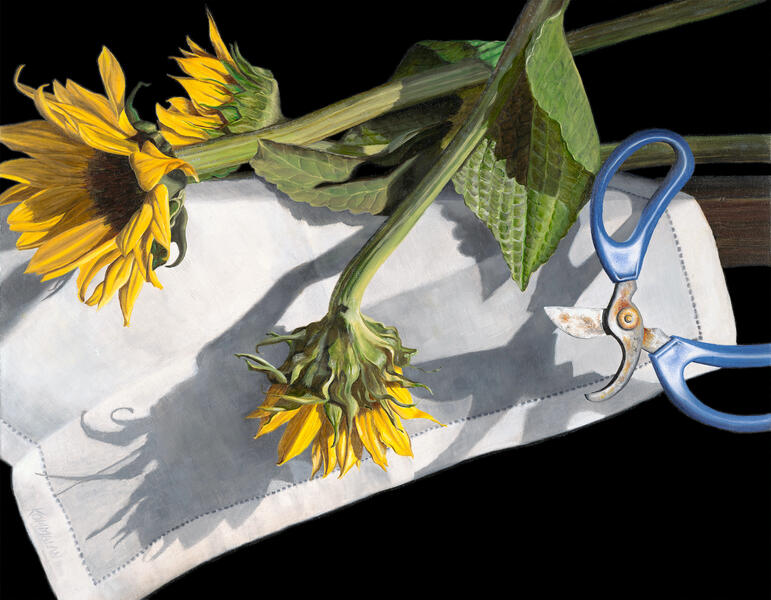 Sunflowers for SteveA commission in the "kinetic" series; still life paintings with falling objects. This painting is designated a semi-finalist in the 2021 ARC 15th Annual Salon. Oil on wood panel. 11" x 14". 2019
Sunflowers for SteveA commission in the "kinetic" series; still life paintings with falling objects. This painting is designated a semi-finalist in the 2021 ARC 15th Annual Salon. Oil on wood panel. 11" x 14". 2019 -
 Eggs and EggplantsThe third in the series with an egg falling off the table. This painting shows a strong influence of abstraction. Oil on wood panel. 11" x 14". 2014
Eggs and EggplantsThe third in the series with an egg falling off the table. This painting shows a strong influence of abstraction. Oil on wood panel. 11" x 14". 2014 -
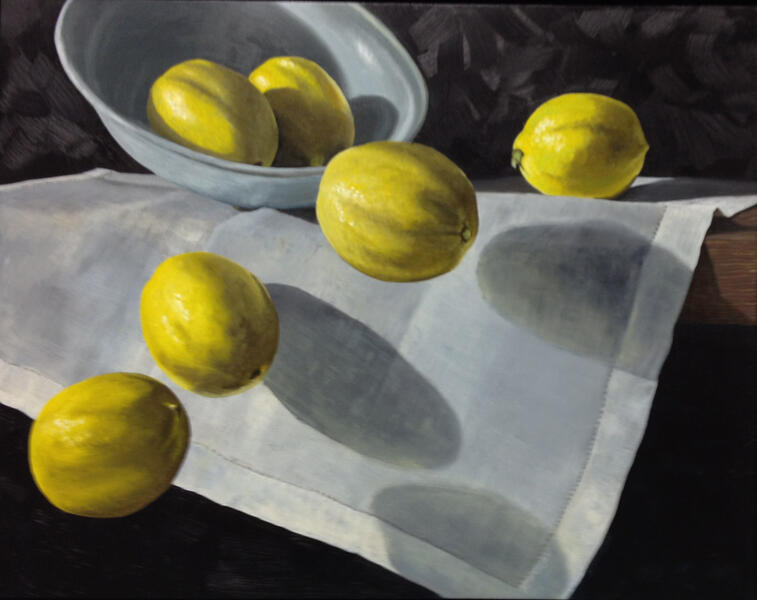 Make Lemonade!The title says it all... Oil on birch panel, 11" x 14". 2014
Make Lemonade!The title says it all... Oil on birch panel, 11" x 14". 2014 -
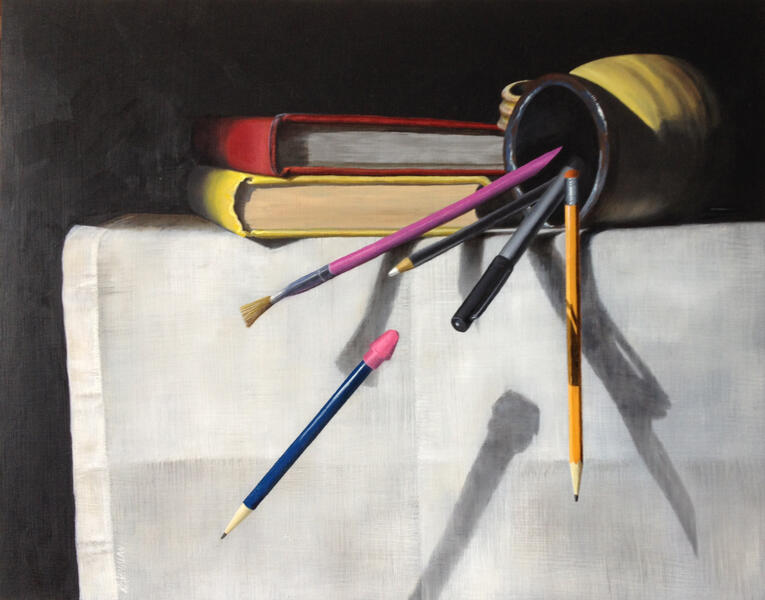 Pens and PencilsOil on birch panel. 11" x 14" This painting was digitally enlarged and chosen to hang in Gallery D at Baltimore Washington International Airport. In October 2021, the copy was entered into the permanent collection there.
Pens and PencilsOil on birch panel. 11" x 14" This painting was digitally enlarged and chosen to hang in Gallery D at Baltimore Washington International Airport. In October 2021, the copy was entered into the permanent collection there. -
Cut and RunBeautiful white lilies are falling off the table! Oil on panel, 11" x 14".
-
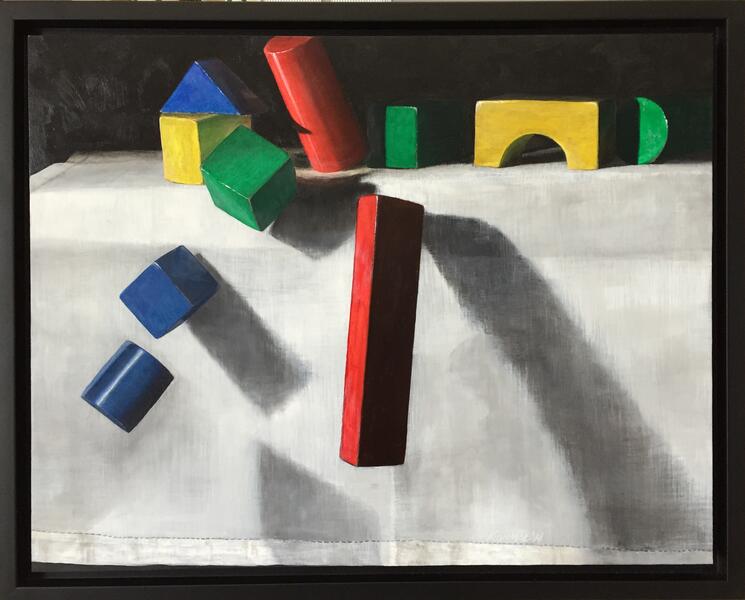 London Bridge...Oil on birch panel. 11" x 14" Another departure from organic shapes, this painting shows how much fun building block can be. Not just for the kids, but for me, too. This title always brings a smile to the viewer. 2014
London Bridge...Oil on birch panel. 11" x 14" Another departure from organic shapes, this painting shows how much fun building block can be. Not just for the kids, but for me, too. This title always brings a smile to the viewer. 2014 -
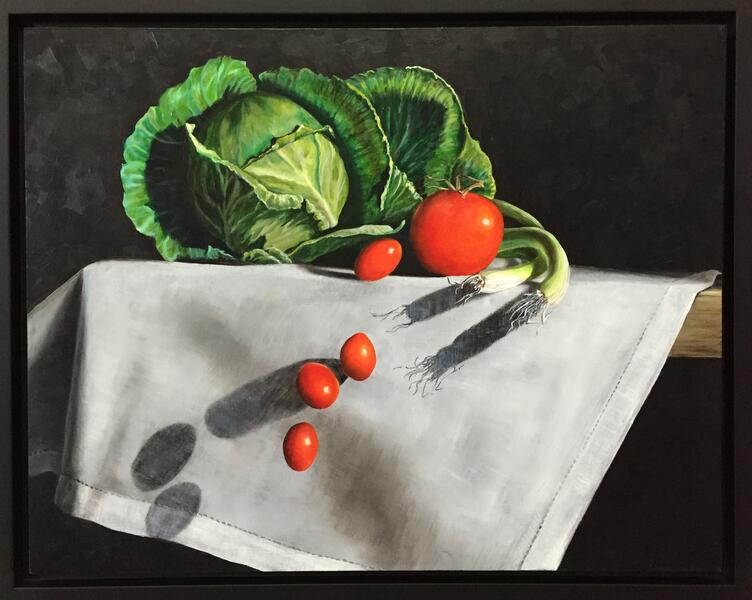 Fall(ing) HarvestOil on birch panel. 11" x 14" Back ti painting vegetables, this painting has tomatoes falling over. That red color enhances the movement and those tomatoes just jump out at you. 2015
Fall(ing) HarvestOil on birch panel. 11" x 14" Back ti painting vegetables, this painting has tomatoes falling over. That red color enhances the movement and those tomatoes just jump out at you. 2015 -
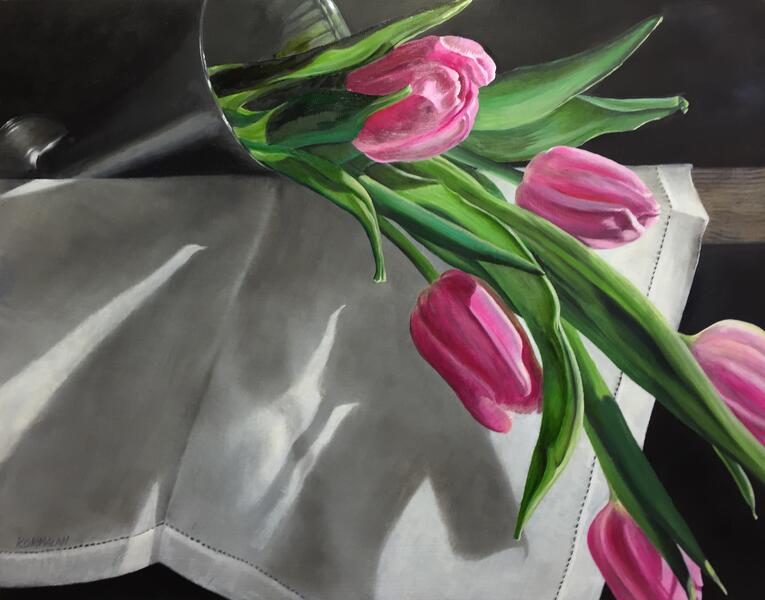 TulipsExploring the idea of "kinetic" still life, I have been working with strong lighting and deep cast shadows. Cast shadows are not necessarily intuitive, but have to be rendered correctly for believability. When I saw these tulips at the store, I was attracted to the intense color. Had to have them! Had to paint them. Eighth in the on-going series. Oil on birch panel. 11" x 14" 2015
TulipsExploring the idea of "kinetic" still life, I have been working with strong lighting and deep cast shadows. Cast shadows are not necessarily intuitive, but have to be rendered correctly for believability. When I saw these tulips at the store, I was attracted to the intense color. Had to have them! Had to paint them. Eighth in the on-going series. Oil on birch panel. 11" x 14" 2015 -
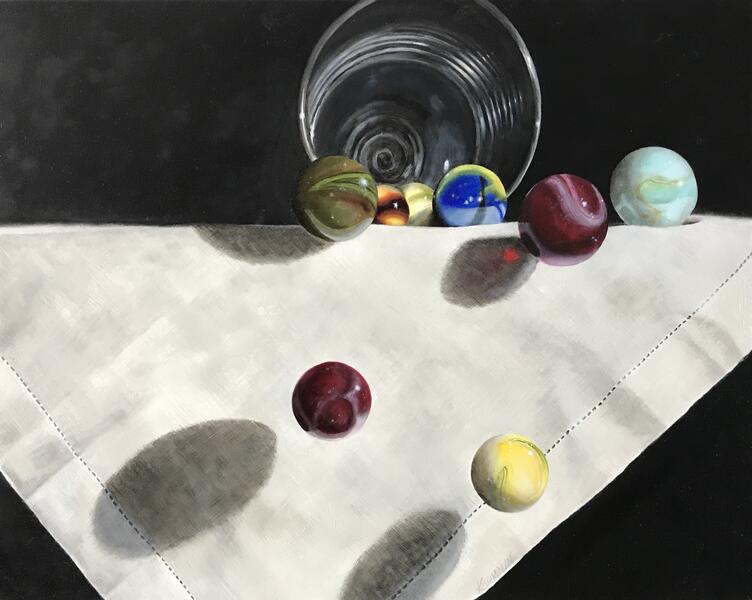 Lost My MarblesAnother "kinetic" still life. It reflects our muddled thinking at times. Oil on panel, 11" x 14"
Lost My MarblesAnother "kinetic" still life. It reflects our muddled thinking at times. Oil on panel, 11" x 14" -
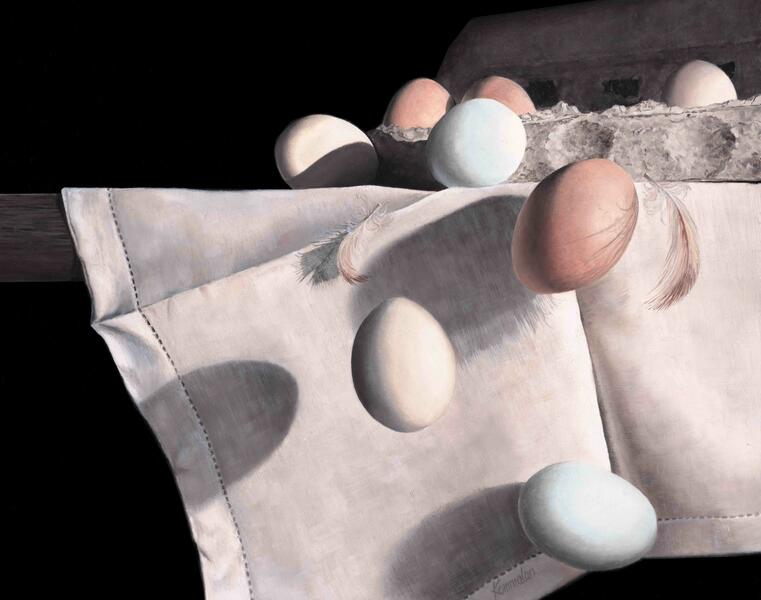 Which Came First?Catch those eggs! Oil on panel, 11" x 14".
Which Came First?Catch those eggs! Oil on panel, 11" x 14".
Small Works
Continuing the series of still lifes with strong contrast, these small paintings on panel depict fruits, vegetables, and other interesting objects. The point is to take a close look at ordinary things.
Most paintings are 5" x 5", all are painted on a panel: either wood, masonite, or archival aluminum.
Most paintings are 5" x 5", all are painted on a panel: either wood, masonite, or archival aluminum.
-
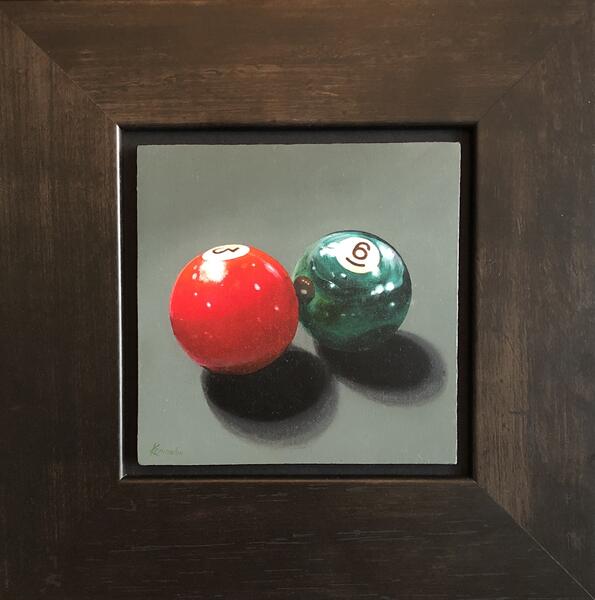 Pool BallsRed and green pool balls, Port and Starboard Series. 5" x 5", oil on panel.
Pool BallsRed and green pool balls, Port and Starboard Series. 5" x 5", oil on panel. -
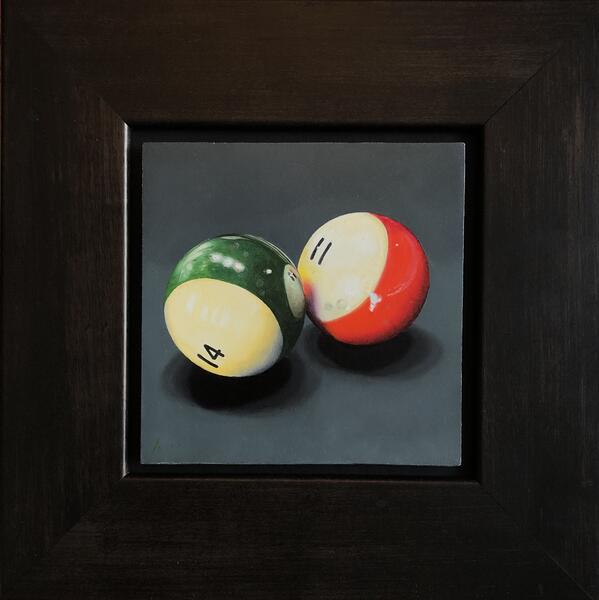 Red Right ReturningThis one is a companion to the Pool Balls painting. Using the striped pool balls, the red and green positions are reversed. Oil on panel, 5"x 5".
Red Right ReturningThis one is a companion to the Pool Balls painting. Using the striped pool balls, the red and green positions are reversed. Oil on panel, 5"x 5". -
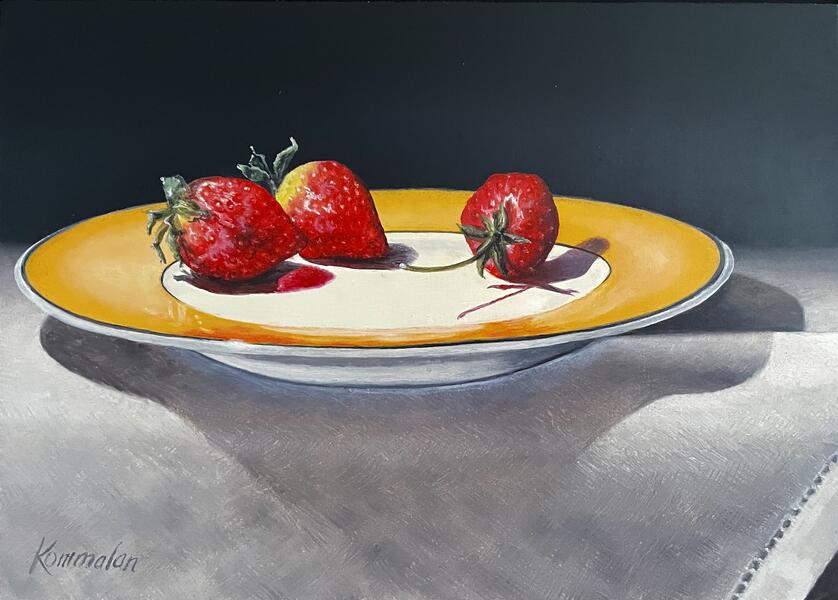 Plated StrawberriesThree strawberries on a plate. Oil on panel, 5" x 7".
Plated StrawberriesThree strawberries on a plate. Oil on panel, 5" x 7". -
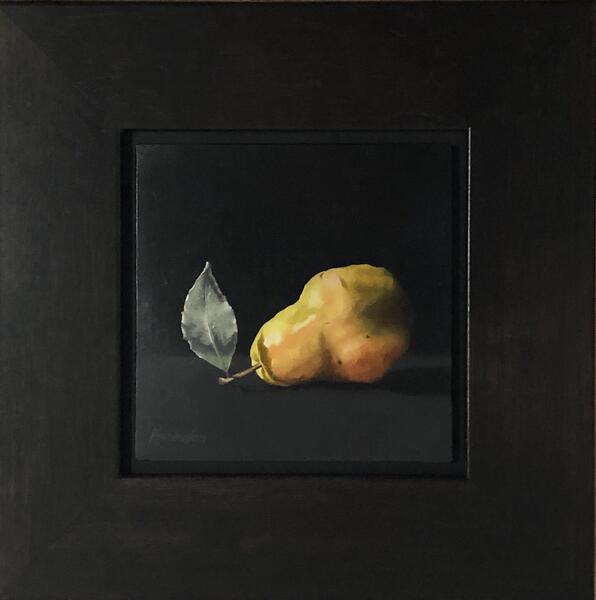 BartlettBartlett pear, oil on panel, 5" x 5".
BartlettBartlett pear, oil on panel, 5" x 5". -
OlivesThree olives in a row, two are olive shells and the last is a green olive. Oil on pane, 5" x 5".
-
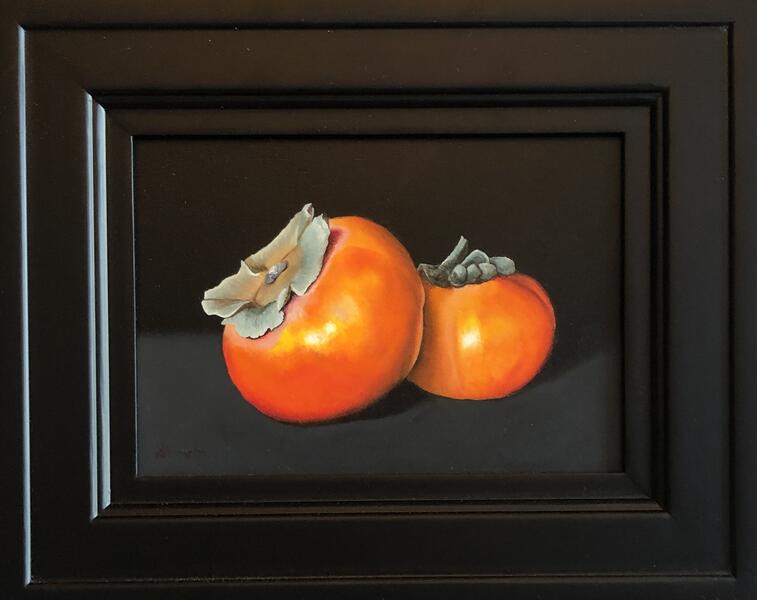 FuyuTwo Fuyu persimmons. Oil on panel, 5" x 7".
FuyuTwo Fuyu persimmons. Oil on panel, 5" x 7". -
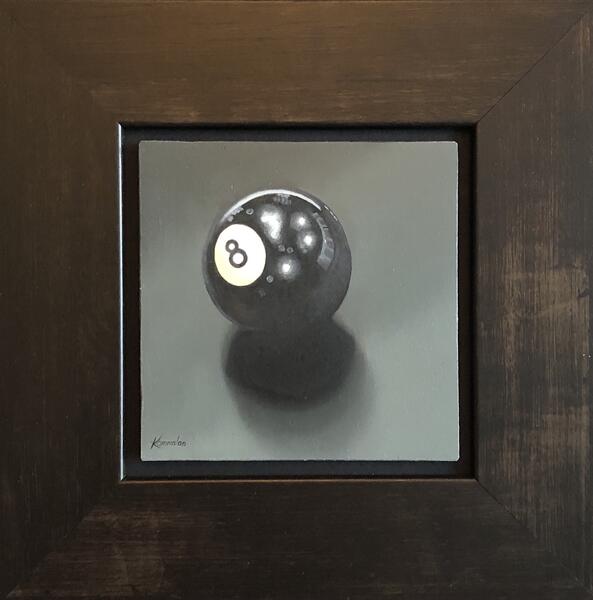 8Solitary eight ball on a pool table. Oil on panel, 5" x 5".
8Solitary eight ball on a pool table. Oil on panel, 5" x 5". -
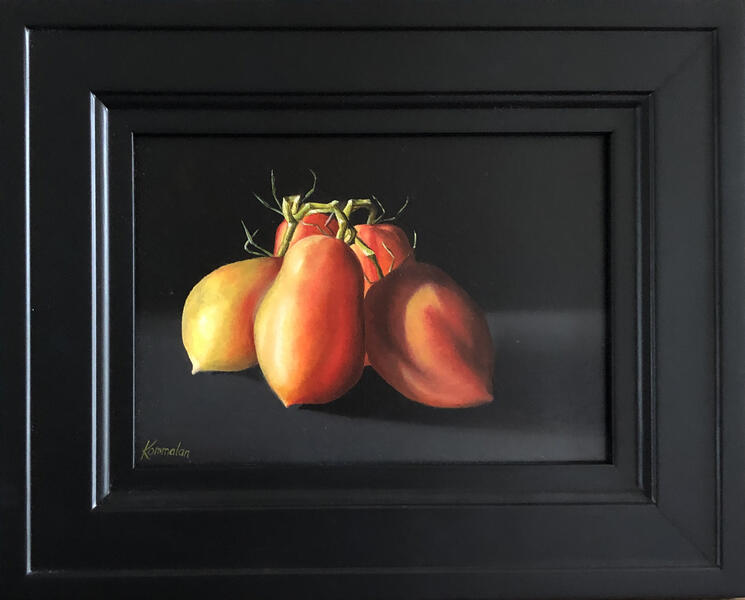 RomasSeveral Roma tomatoes on a branch. Oil on panel, 5" x 7".
RomasSeveral Roma tomatoes on a branch. Oil on panel, 5" x 7". -
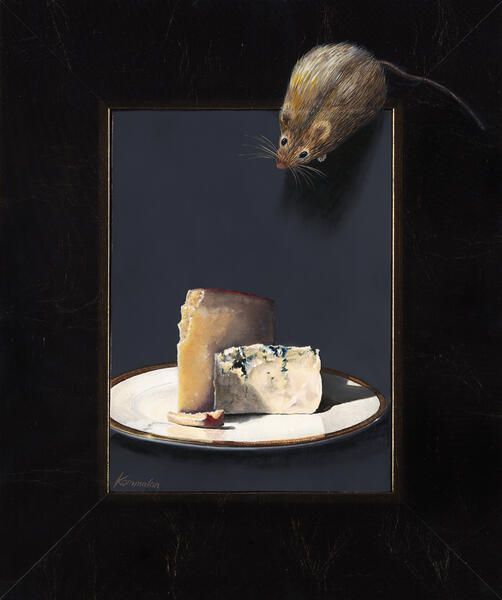 And the Mouse Takes the CheeseOil on panel, 8" x 6", with a few additional inches as the mouse is painted directly onto the frame.
And the Mouse Takes the CheeseOil on panel, 8" x 6", with a few additional inches as the mouse is painted directly onto the frame.
Grenade Series
Started in 2016, this series has proven to be very popular. I started it to learn how to capture metal textures. For me, part of the excitement is the visual puns. Have fun looking at these!
-
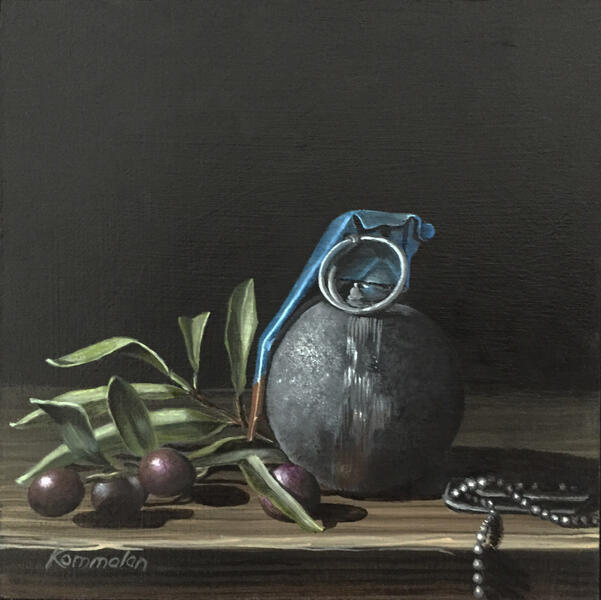 War and PeaceThe first go at painting a grenade. 5"x5". Oil on panel.
War and PeaceThe first go at painting a grenade. 5"x5". Oil on panel. -
 Still Life with PineapplesThis painting shows two very different pineapples. Oil on panel, 8" x 10".
Still Life with PineapplesThis painting shows two very different pineapples. Oil on panel, 8" x 10". -
 Les GrenadesA classic still life composition with a twist... here grenade is French for pomegranate. Oil on panel, 11" x 14".
Les GrenadesA classic still life composition with a twist... here grenade is French for pomegranate. Oil on panel, 11" x 14". -
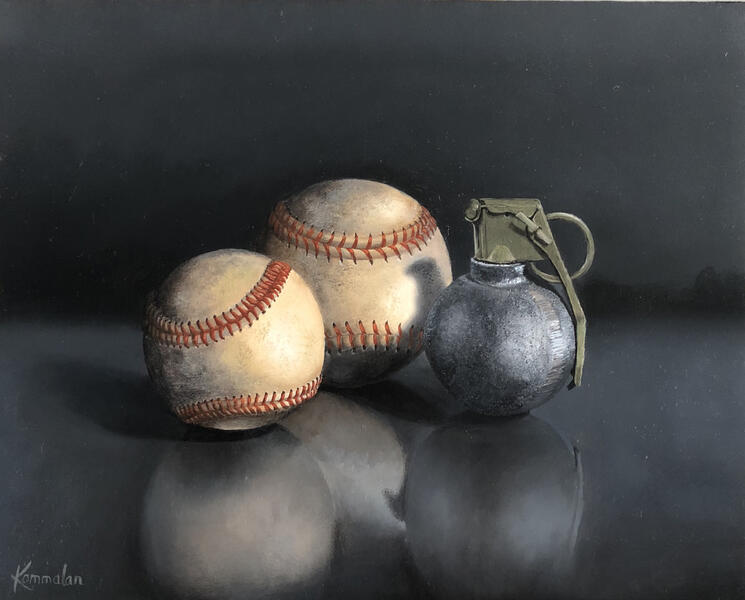 Strike ThreeShowing a "baseball" grenade, this painting was titled by the collector before it was finished. Oil on panel, 8" x 10".
Strike ThreeShowing a "baseball" grenade, this painting was titled by the collector before it was finished. Oil on panel, 8" x 10". -
 ShellshockedTwo seashells and a grenade. Oil on panel, 8" x 10".
ShellshockedTwo seashells and a grenade. Oil on panel, 8" x 10". -
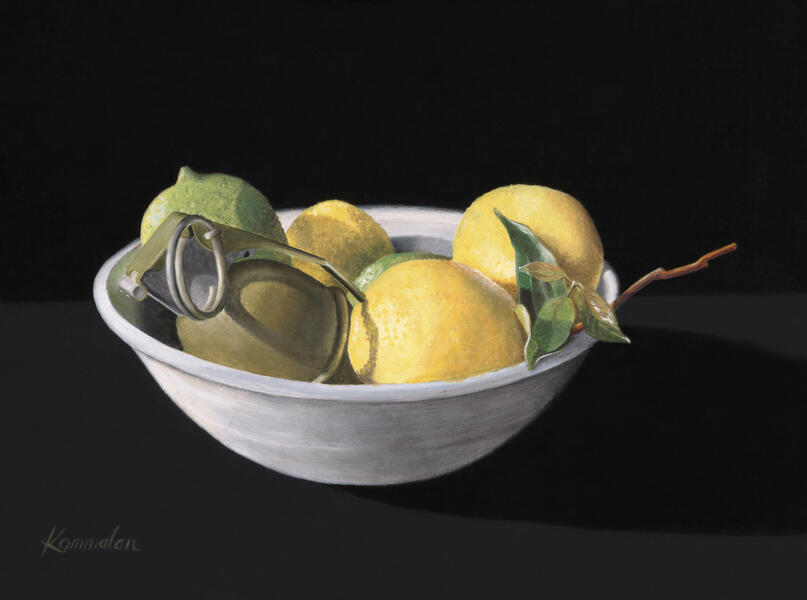 Lemons and LimesA ceramic bowl holds an assortment of lemons and limes which include a "lemon" grenade. Oil on panel, 6" x 8".
Lemons and LimesA ceramic bowl holds an assortment of lemons and limes which include a "lemon" grenade. Oil on panel, 6" x 8". -
 Exotic CitrusA classic still life composition with a twist, this painting is a collection of unusual citrus fruits combined with a "lemon" grenade. Oil on panel, 8" x 10".
Exotic CitrusA classic still life composition with a twist, this painting is a collection of unusual citrus fruits combined with a "lemon" grenade. Oil on panel, 8" x 10". -
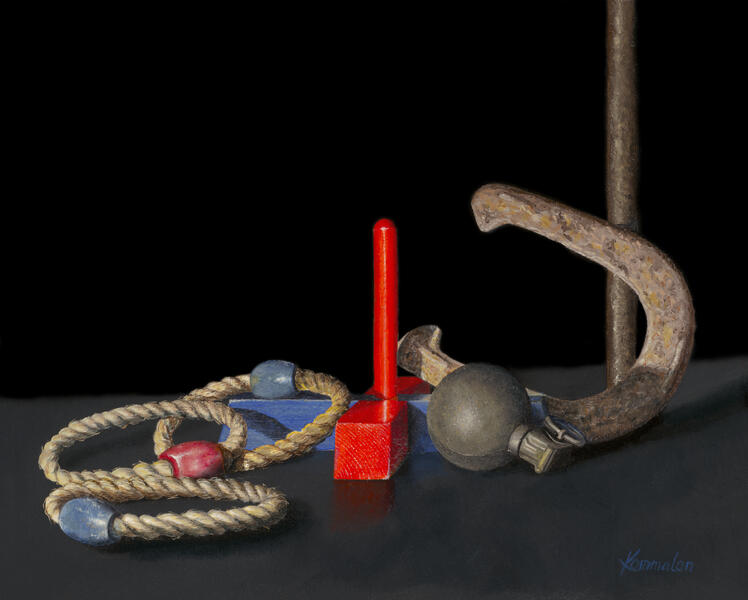 Horseshoes and Hand GrenadesThis piece illustrates the adage, "close only counts in horseshoes and hand grenades". Oil on panel, " x 10".
Horseshoes and Hand GrenadesThis piece illustrates the adage, "close only counts in horseshoes and hand grenades". Oil on panel, " x 10".
Chalkboard Series
Begun in 2020, this new series is trompe l'oeil chalkboard paintings. People have been afraid to touch them, thinking they will be smeared. An interesting part for me has been to research the math to be sure it is correct! A bit of whimsey.
-
 FibonacciFirst in this series, an illustration of the Fibonacci number series. Oil and gold leaf on panel, 8" x 6".
FibonacciFirst in this series, an illustration of the Fibonacci number series. Oil and gold leaf on panel, 8" x 6". -
 Solve for b...An illustration of the Pythagorean Theorem. Oil and gold leaf on panel, 8" x 6".
Solve for b...An illustration of the Pythagorean Theorem. Oil and gold leaf on panel, 8" x 6". -
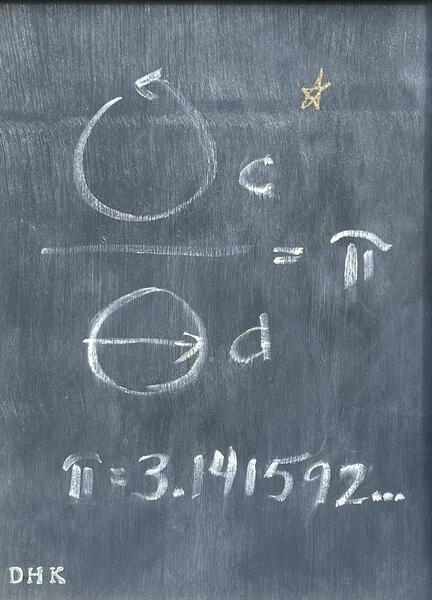 More Pi, PleaseAn illustration of the formula for pi. Oil and gold leaf on panel. 8" x 6".
More Pi, PleaseAn illustration of the formula for pi. Oil and gold leaf on panel. 8" x 6". -
 Proposition 1An illustration of one of Euclid's Elements. Oil and gold leaf on panel, 8" x 6".
Proposition 1An illustration of one of Euclid's Elements. Oil and gold leaf on panel, 8" x 6".
Kiltmaker
I have been a professional kiltmaker in the Baltimore, Washington, and Pennsylvania area for 40 years. Kiltmaking is highly specific form of tailoring. Tartan is a special form of plaid; tartans are named plaids. Besides family and clan tartans, there are district, province, and national tartans; besides Scottish tartans, there are Irish, Welsh, Canandian, and tartans specific to schools, universities, and other organizations. Tartan is specially woven for kiltmaking; twilled to the edge so the selvedge can be used for the hemline.
Within the tartan families, there are different colorways. Modern colors are quite brilliant and basic, for example, the reds are bright scarlet, whereas the ancient colors are more subtle, the reds becoming a soft red-orange, as perhaps faded over time. Also, there are muted shades and weathered shades. For instance, one can order a kilt and specify 'weathered hunting Stewart'. I find that my clients educate me!
There are many different pleating patterns one can choose. The most common is pleating to sett. A sett is a complete repeat of a tartan design. Pleating to stripe means that the lightest stripe is centered in the pleat face, this is commonly done for military kilts, but can be done for most any tartan. Other choices include pleating to alternating pivot points, pleating to a field color or alternating fields, pleating to a preferred stripe, or simply to a pleasing pattern.
In my career I have made many items for the Scottish community. I am nearing 800 different tartan projects. I currently limit my work to kilts, kilted skirts (for ladies), plaids for pipers and drummers, and bagpipe covers. A kilt generally takes eight yards of fabric, a prodigious amount.
Within the tartan families, there are different colorways. Modern colors are quite brilliant and basic, for example, the reds are bright scarlet, whereas the ancient colors are more subtle, the reds becoming a soft red-orange, as perhaps faded over time. Also, there are muted shades and weathered shades. For instance, one can order a kilt and specify 'weathered hunting Stewart'. I find that my clients educate me!
There are many different pleating patterns one can choose. The most common is pleating to sett. A sett is a complete repeat of a tartan design. Pleating to stripe means that the lightest stripe is centered in the pleat face, this is commonly done for military kilts, but can be done for most any tartan. Other choices include pleating to alternating pivot points, pleating to a field color or alternating fields, pleating to a preferred stripe, or simply to a pleasing pattern.
In my career I have made many items for the Scottish community. I am nearing 800 different tartan projects. I currently limit my work to kilts, kilted skirts (for ladies), plaids for pipers and drummers, and bagpipe covers. A kilt generally takes eight yards of fabric, a prodigious amount.
-
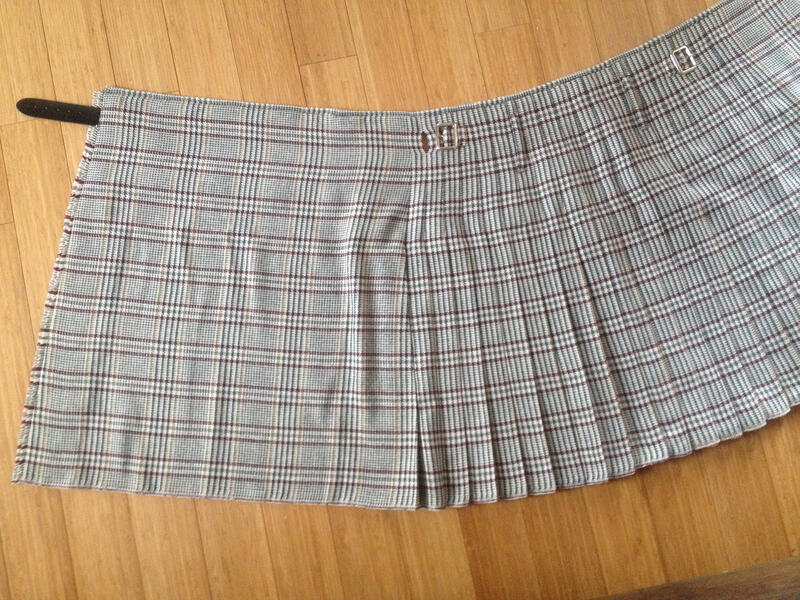 Tweed kiltSomething very different. Americans are used to seeing kilts made from tartan plaids. Tweeds kilts are seen more often in Scotland; they are proper and not an aberration. It was a pleasure to make something different. This fabric is rather soft and will not hold a sharp pleat, but is special to the client. It made up well and will be a conversation starter!
Tweed kiltSomething very different. Americans are used to seeing kilts made from tartan plaids. Tweeds kilts are seen more often in Scotland; they are proper and not an aberration. It was a pleasure to make something different. This fabric is rather soft and will not hold a sharp pleat, but is special to the client. It made up well and will be a conversation starter! -
 The Fralec familySometimes I am asked to outfit a family for a special occasion. Shown here: two modern Red Scott kilts, two ancient Green Scott kilts and one US Navy kilt.
The Fralec familySometimes I am asked to outfit a family for a special occasion. Shown here: two modern Red Scott kilts, two ancient Green Scott kilts and one US Navy kilt. -
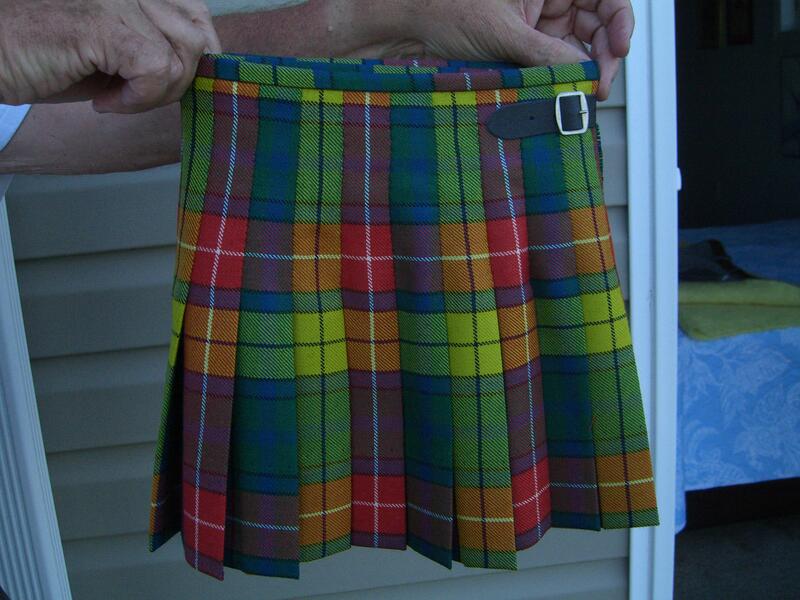 Clan BuchananThis tartan is Buchanan in the ancient colors. It is a very tiny kilt, made especially for a wedding. 11" long, with 3" of hem for future growth. As the kilt is so small, it could only be pleated approximately to sett. Certainly there is nothing inappropriate in pleating a kilt to a pleasing pattern!
Clan BuchananThis tartan is Buchanan in the ancient colors. It is a very tiny kilt, made especially for a wedding. 11" long, with 3" of hem for future growth. As the kilt is so small, it could only be pleated approximately to sett. Certainly there is nothing inappropriate in pleating a kilt to a pleasing pattern! -
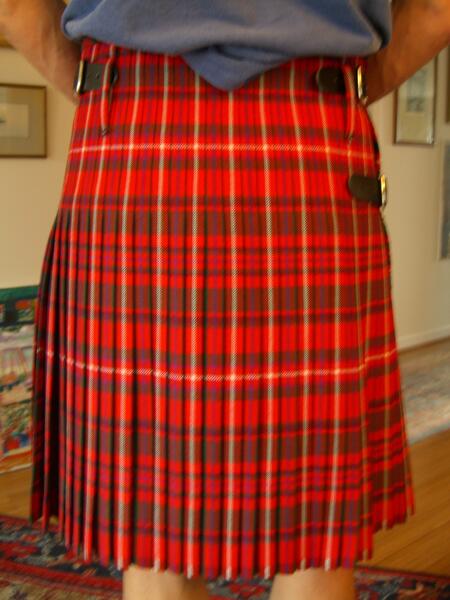 Clan MacKinnonThis is modern red MacKinnon, pleated to the alternating pivot point.
Clan MacKinnonThis is modern red MacKinnon, pleated to the alternating pivot point. -
 Clan BuchananThis Old Buchanan tartan is the muted colors. The client had a choice of pleating to the burgundy stripe or to the teal stripe. He chose the burgundy, which made a spectacular and singular kilt.
Clan BuchananThis Old Buchanan tartan is the muted colors. The client had a choice of pleating to the burgundy stripe or to the teal stripe. He chose the burgundy, which made a spectacular and singular kilt. -
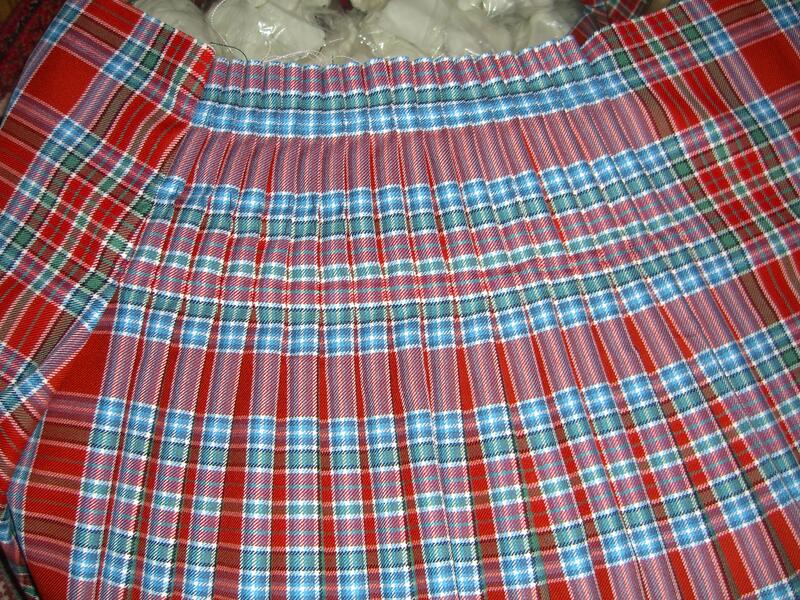 Clan MacBeanFor this kilt the client chose pleating to the light blue stripe, an unusual choice. Tartan is in the ancient colors, note the red is actually a deep orange shade instead of a true scarlet.
Clan MacBeanFor this kilt the client chose pleating to the light blue stripe, an unusual choice. Tartan is in the ancient colors, note the red is actually a deep orange shade instead of a true scarlet. -
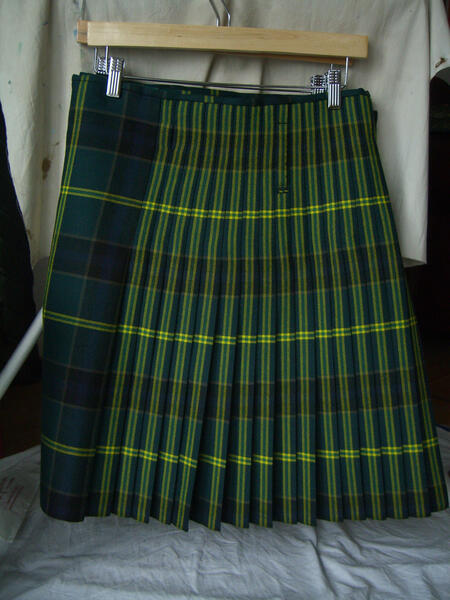 US Army tartanUS Army is a tartan available to be worn by anyone who has served. It is proper for any military tartan be pleated to stripe instead of to sett. Pleating to stripe means that the lightest stripe is centered in the pleat face. A tartan in the modern colors.
US Army tartanUS Army is a tartan available to be worn by anyone who has served. It is proper for any military tartan be pleated to stripe instead of to sett. Pleating to stripe means that the lightest stripe is centered in the pleat face. A tartan in the modern colors. -
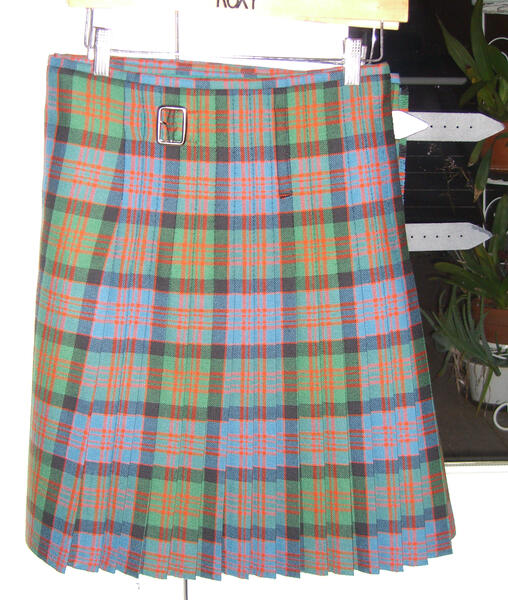 Clan DonaldThis is a Clan Donald kilt, specifically a MacDonald tartan. It is pleated to sett, which means the total plaid is visible in the pleating across the back. The client chose the ancient colors.
Clan DonaldThis is a Clan Donald kilt, specifically a MacDonald tartan. It is pleated to sett, which means the total plaid is visible in the pleating across the back. The client chose the ancient colors. -
 Royal StewartThis kilt is pleated to sett, showing the complete repeat of the pattern of the tartan. Royal Stewart tartan is designated by the British royalty for wear by pipe bands, which explains why it is seen quite often. It is also very popular in the US for general clothing and is seen in the fall and winter in woollen items. It is the modern colors.
Royal StewartThis kilt is pleated to sett, showing the complete repeat of the pattern of the tartan. Royal Stewart tartan is designated by the British royalty for wear by pipe bands, which explains why it is seen quite often. It is also very popular in the US for general clothing and is seen in the fall and winter in woollen items. It is the modern colors. -
 Clan Cameron (Erracht)This photo shows a kilt laid out flat. You can see the pleated section is centered and will be worn in the back. The two flat sections are called "aprons" and will cross over the front of the body. The aprons are not pleated and show the design of the plaid. This client chose the pleats to stripe, as is proper for a military kilt. The former regiment of the Queen's Own Cameron Highlanders wore this tartan.
Clan Cameron (Erracht)This photo shows a kilt laid out flat. You can see the pleated section is centered and will be worn in the back. The two flat sections are called "aprons" and will cross over the front of the body. The aprons are not pleated and show the design of the plaid. This client chose the pleats to stripe, as is proper for a military kilt. The former regiment of the Queen's Own Cameron Highlanders wore this tartan.
